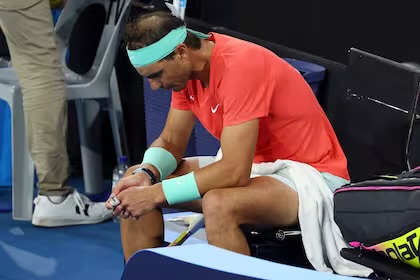Rafael Nadal is in a trap that is easy to get out of. But not really, it is actually extremely difficult to do so, because Nadal is a prisoner of a stalemate between three forces that rule his being, his heart and his tennis armour.
Tennis tells him that he is fit to keep playing and winning.
The body tells him that it is time to retire, that he has had enough.
The mind, which throughout his career was the great differential of Nadal, the engine of his ambition, his tenacity and his victories. And his common sense.
What will the mind pay attention to: the evidence of a physique that betrays him with increasing frequency, or the heart and soul of a champion?
The mind is at work, but apparently not ready to decide yet. Just read Nadal’s posts on the social networking site X. Twice, while announcing a small muscle tear after months of working on recovering and regenerating his body, the Spaniard speaks of “good news” and “not so bad news”. It’s as if he’s trying to convince himself that not playing the Australian Open is a minor issue.
And the truth is it’s not, Australia was a big target. It wasn’t about winning the tournament, of course not, but it was about getting back to it and playing it. It was about competing, which is what Nadal is obsessed with. He needs to compete, because otherwise winning will be impossible. It was about nothing more and nothing less than playing tennis, about being a tennis player.
So Nadal is in a very complex situation: he is not competitive because he does not compete. And he does not compete because his physique today tells him that enough is enough, that that’s it. His body, and it is a huge paradox, is preventing him from being a tennis player.
“Rafael will exhaust his possibilities because he loves tennis much more for everything it gives him than for everything it takes away,” said Toni Nadal, his uncle and coach for many years, in a column in “El País”.
But at 37 and a half years old, the end is near. “This time the situation is much more complicated and it will probably be the last time we see him come back after his body has forced him to retire temporarily. The reasons are very clear. In previous comebacks, he had to compete with players of his own generation, while nowadays his opponents are much younger and are developing a new type of tennis in which one of the most decisive characteristics is the will to hit the ball faster and faster”.
One last bet remains, which is the great objective that the Spaniard had set himself: to be fit and competitive in the clay-court season, the keystone of his career, the weeks that made Nadal a legend, with Roland Garros as the big stage. Without those triumphs and that blind confidence achieved on clay, Nadal would not have extended his dominance to other surfaces and tournaments for two decades.
And before the orange spring in Europe comes the faint hope of the ATP 250 in Buenos Aires and 500 in Rio de Janeiro, two tournaments Nadal won in his time. Playing in South America to add matches and confidence for Europe and Roland Garros was a good recipe after other long breaks.
One of the two tournaments acknowledged CLAY that the hope of having Nadal is real, although the doubt prevails: “He will be without playing several weeks, we do not know if he would reach the South American tour”.
Buenos Aires is played between 12 and 18 February, while Rio takes place the following week, from 19 to 25.
Juan Mónaco, Nadal’s close friend, told CLAY months ago: “He’s coming back to the tour to win. If not, he doesn’t come back”.
A year ago, after the injury at the Australian Open, Nadal’s technical group spoke of a four-week break and then a return to the tour. The four weeks turned into 50, in 11 months.
“See you soon,” Nadal said in the “X” message in which he resigned from Australia. Never has such a seemingly banal phrase meant so much.









